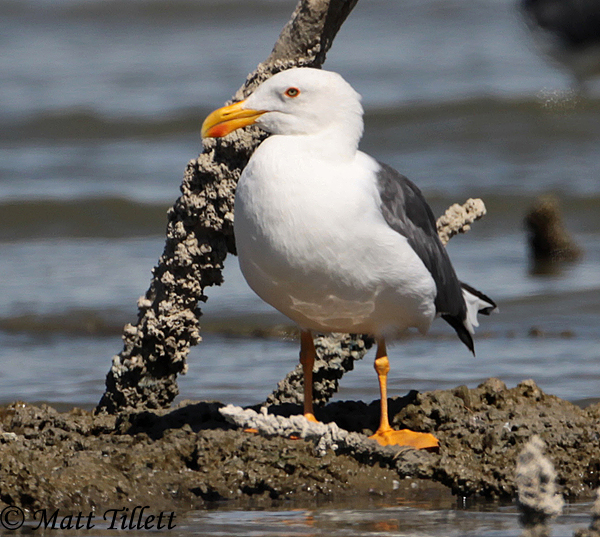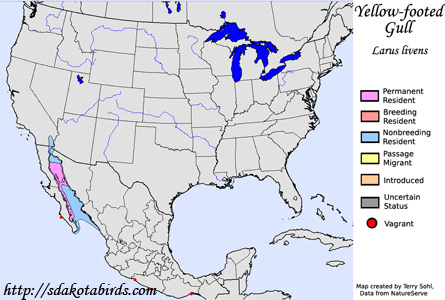| Length: 27 inches | Wingspan: 60 inches | Seasonality: Non-resident in South Dakota |
| ID Keys: Dark gray back, white head and underparts, red dot on lower mandible, large heavy bill, bright yellow legs | ||
 The
Yellow-footed Gull is a large gull species with a small geographic range,
nesting only in and around the Gulf of California and the Baja Peninsula.
In the United States, they are regular post-breeding visitors to the Salton
Sea in southern California, but total number of birds found in the United
States is typically quite small.
The
Yellow-footed Gull is a large gull species with a small geographic range,
nesting only in and around the Gulf of California and the Baja Peninsula.
In the United States, they are regular post-breeding visitors to the Salton
Sea in southern California, but total number of birds found in the United
States is typically quite small.
Habitat: Found near the shoreline in most seasons, rarely venturing far out to sea. Found on open shorelines of the Salton Sea when they visit the United States.
Diet: Feeds heavily on fish, but will also feed on crustaceans, mollusks, marine worms, eggs and young birds, carrion, and refuse.
Behavior: Foraging behavior depends upon food item and location. They will walk in terrestrial habitats, swim on the ocean's surface and pluck items near the surface, or sometimes will make short plunges into the water.
Nesting: A colonial nester, the nest of a Yellow-footed Gull is a shallow scrape on the ground, lined with seaweed and other plant material, placed on a beach near the high tide line. The female usually lays 3 eggs, and both parents help to incubate them. When the eggs hatch, both parents help to raise the young. The young fledge about 6 weeks after hatching.
Song: Has a steady, nasal voice, less harsh than many gull species.
Migration: Considered a permanent resident in and around the Gulf of California. Small numbers move northwards after breeding season, reaching the Salton Sea in California.
Interactive eBird map: Click here to access an interactive eBird map of Yellow-footed Gull sightings
Similar Species: Similar to Western Gull, but leg color differentiates the two species. The Lesser Black-backed Gull also has a dark mantle and bright yellow legs, but is considerably smaller with a less heavy bill.
Conservation Status: There are currently no significant conservation concerns for the species, as populations are relatively large and appear to be stable. The IUCN lists the Yellow-footed Gull as a species of "Least concern".
Further Information: 1) Audubon - Yellow-footed Gull
2) BirdLife International - Yellow-footed Gull
3) American Bird Conservancy - Watch List - Yellow-footed Gull
Photo Information: Photo taken by Matt Tillettt - October 9th, 2011 - Salton Sea, California - Photo licensed under Creative Commons Attribution 2.0 Generic License.
| Click below for a higher-resolution map |
 |
| South Dakota Status: Non-resident in South Dakota |
Additional Yellow-footed Gull Photos (coming soon!!)
